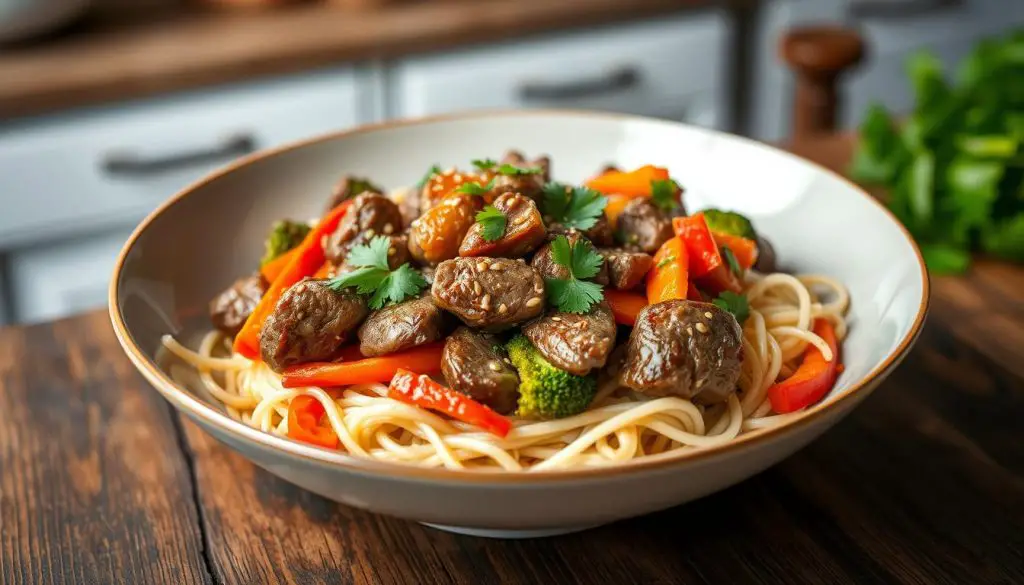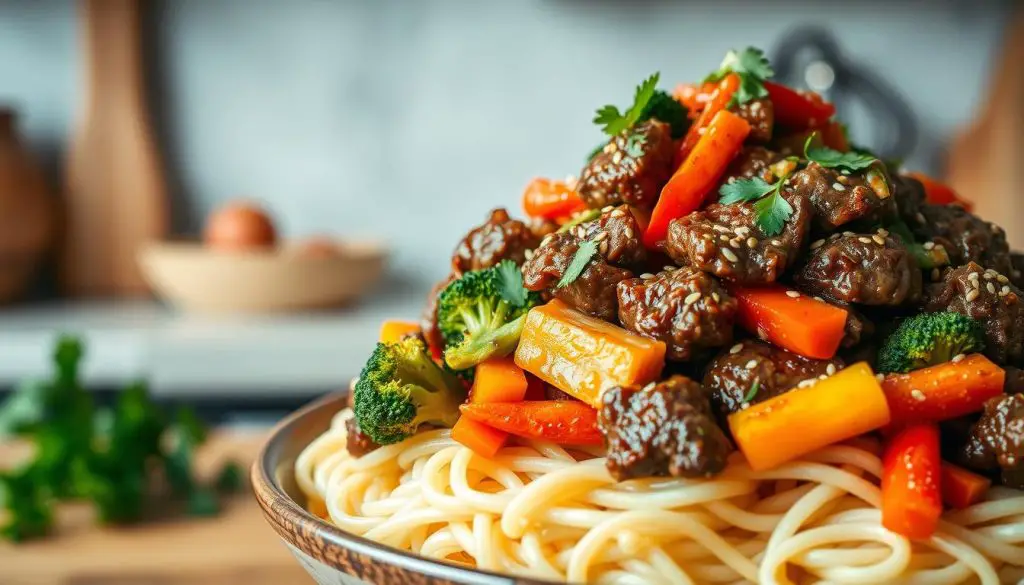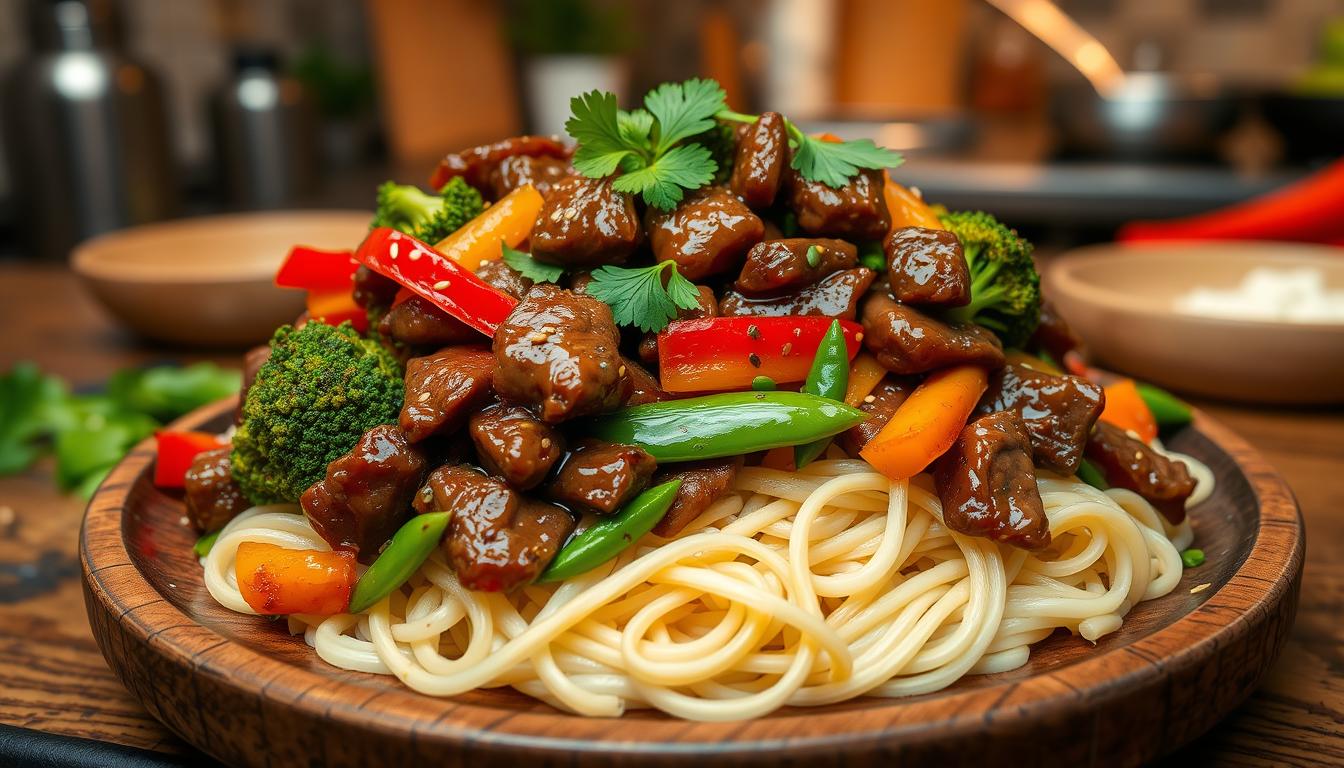Could a simple stir-fry dish help manage fibromyalgia symptoms? The answer might be yes. Studies show that eating foods that fight inflammation can improve life for those with fibromyalgia. Interestingly, 75% of the recipes listed are gluten-free and grain-free, perfect for those with dietary restrictions.
In this article, we’ll dive into a tasty beef stir-fry with rice noodles. It’s great for fibromyalgia because it has lean beef and fiber-rich noodles. This meal is packed with nutrients to help manage symptoms. We’ll also share tips on meal prep and how to customize it for your needs.
What is Fibromyalgia and Why Diet Matters
Fibromyalgia is a long-term condition that causes widespread pain, fatigue, and sleep issues. The exact cause is not known, but diet is key in managing symptoms.
Understanding Fibromyalgia and Its Symptoms
Fibromyalgia brings chronic pain, stiffness, fatigue, sleep problems, and brain fog. It greatly affects a person’s life and is hard to manage.
The Role of Anti-Inflammatory Diet in Managing Fibromyalgia
An anti-inflammatory diet helps those with fibromyalgia. It focuses on whole, nutrient-rich foods to reduce inflammation and boost health. Research shows it can lessen pain, improve sleep, and enhance mental function.
A 2019 review in the Annals of Medicine found diet helped in five out of seven studies. It improved sleep, reduced depression and anxiety, and enhanced life quality for fibromyalgia patients. Another study in the International Journal for Vitamin and Nutrition Research found antioxidant-rich diets helped fibromyalgia patients have fewer tender points and better life quality.
On the other hand, foods like refined white flour, sugary cereals, red meat, processed meats, and dairy are not good for fibromyalgia. An anti-inflammatory diet and avoiding these foods can help manage fibromyalgia and improve overall health.
Benefits of Beef Stir-Fry with Rice Noodles for Fibromyalgia
The beef stir-fry with rice noodles recipe is great for those with fibromyalgia. The lean protein from the beef helps muscles work better and recover faster. This is key for managing fibromyalgia symptoms. Also, the high-fiber rice noodles help with digestion, which is vital for overall health in fibromyalgia patients.
Lean Protein Source for Muscle Support
Beef is a lean protein source that supports muscle function and recovery. People with fibromyalgia often have muscle pain and weakness. Eating lean protein helps keep and build muscle, easing some fibromyalgia symptoms.
High-Fiber Rice Noodles for Digestive Health
The high-fiber rice noodles in this recipe boost digestive health. This is key for those with fibromyalgia, as they often face digestive issues. Fiber-rich foods like these noodles help keep bowel movements regular and support gut health.
| Nutrient | Rice Noodles (1 cup cooked) | Whole Wheat Pasta (1 cup cooked) | Spaghetti Squash (1 cup cooked) |
|---|---|---|---|
| Calories | 190 | 220 | 42 |
| Protein (g) | 3.2 | 7.5 | 1.0 |
| Fat (g) | 0.4 | 1.3 | 0.1 |
| Carbohydrates (g) | 42.2 | 43.2 | 10 |
| Fiber (g) | 1.8 | 5.5 | 2.2 |
| Sodium (mg) | 33.4 | 2 | 28 |
| Selenium (% DV) | 14% | 30% | 1% |
This table shows rice noodles are a lower-calorie and lower-carb option than traditional pasta. They also have a lot of fiber. This high-fiber content is great for fibromyalgia patients, who often have digestive problems.
Beef stir-fry with rice noodles for fibromyalgia
Living with fibromyalgia can make finding good food tough. But, a fibromyalgia-friendly beef stir-fry with rice noodles is a great find. It’s packed with lean protein, anti-inflammatory foods, and fiber. This makes it a great meal for managing fibromyalgia symptoms.
The lean beef flank steak in this dish is key. It’s full of protein to help muscles heal and grow. The recipe also includes chili peppers, ginger, garlic, and green onions. These veggies help fight inflammation and pain.
The rice noodles in this dish are also important. They help with digestion and regular bowel movements, a big issue for fibromyalgia patients. Plus, using avocado oil instead of regular oils adds more health benefits. Avocado oil is known for its anti-inflammatory effects.
| Ingredient | Quantity |
|---|---|
| Beef Flank Steak | 1 pound |
| Rice Noodles | 8 ounces |
| Avocado Oil | 2 tablespoons |
| Chili Peppers | 2, sliced |
| Ginger | 1 tablespoon, minced |
| Garlic | 3 cloves, minced |
| Green Onions | 4, sliced |
Adding this beef stir-fry with rice noodles to your fibromyalgia-friendly diet can be a game-changer. It’s a tasty and healthy meal that might ease your symptoms and boost your health.

Easy Meal Prep for Fibromyalgia
Living with fibromyalgia can make meal prep hard because of fatigue and low energy. But, there are ways to make tasty, easy meals that fit your diet needs. Stir-frying is a great method because it’s quick and helps manage fatigue with fibromyalgia.
Low-Impact Cooking for Managing Fatigue
Stir-frying is a low-impact cooking method. It quickly cooks ingredients in a hot pan or wok. This keeps nutrients in and makes a full meal with little effort.
Just a few minutes of active cooking can save a lot of energy. You can then focus on other meal prep tasks like chopping veggies or making sides.
Stir-frying is perfect for easy meal prep for fibromyalgia. It uses simple ingredients and quick cooking. This way, you get a healthy meal without the stress of long prep or cleanup.
To make it even easier, use pre-chopped veggies or a food processor. This cuts down on physical effort. It helps manage fatigue and makes meal prep more doable.

Stir-frying and other low-impact cooking methods make mealtime less stressful. They let you enjoy healthy meals without using up too much energy. This is a big help for those with fibromyalgia, helping them stick to a healthy diet while saving energy.
Nutrient-Dense Meal for Fibromyalgia
Managing fibromyalgia means eating nutrient-rich meals. The beef stir-fry with rice noodles is a great choice. It has protein, carbs, and anti-inflammatory nutrients. These help with symptoms and improve health.
Nutrient-dense meals are key for fibromyalgia. Lean beef provides protein for muscles. Rice noodles offer fiber for digestion and energy. The stir-fry also has veggies that fight inflammation and pain.
The importance of nutrition for fibromyalgia is huge. A balanced diet helps your body handle symptoms better. Focus on antioxidants, vitamin B12, magnesium, and omega-3s.
- Antioxidants from fruits and vegetables to combat oxidative stress
- Vitamin B12 for energy production and nerve function
- Magnesium to support muscle and nerve health
- Omega-3 fatty acids from sources like fatty fish or supplements to reduce inflammation
Adding these nutrients to your diet can greatly improve health and symptom control. Every person’s needs are different. Work with your healthcare team to find the right diet for you.

The beef stir-fry with rice noodles is a great meal for fibromyalgia. It’s full of healthy, anti-inflammatory foods. By eating well, you can help your body and reduce symptoms. Take charge of your health with a balanced diet.
Anti-Inflammatory Ingredients in the Recipe
The beef stir-fry with rice noodles recipe has many anti-inflammatory ingredients. These can help lower inflammation and ease fibromyalgia symptoms. They are tasty and have special benefits for those with this chronic condition.
Identifying Inflammation-Fighting Foods
Beef is a lean protein in the recipe. It supports muscle health and is rich in zinc. Zinc has anti-inflammatory properties that may reduce pain and stiffness in fibromyalgia patients.
The recipe also includes ginger and turmeric. These spices are known for their anti-inflammatory effects. Gingerols in ginger can stop inflammatory molecules, while curcumin in turmeric may help with pain and well-being in fibromyalgia patients.
Other anti-inflammatory ingredients in the recipe are:
- Broccoli, which is full of sulforaphane, a compound that fights inflammation and oxidative stress
- Bell peppers, which are packed with vitamin C and have strong anti-inflammatory properties
- Mushrooms, which have antioxidants that fight inflammation
Adding these inflammation-fighting foods to your diet can help manage fibromyalgia symptoms. It supports your overall health.

Remember, a anti-inflammatory diet is just part of managing fibromyalgia. It’s key to work with your healthcare provider. Together, you can create a full treatment plan for your condition.
Customizing the Recipe for Your Needs
Managing fibromyalgia often means finding the right diet. The beef stir-fry with rice noodles recipe is fibromyalgia-friendly. But, you might need to make changes to fit your dietary needs and taste.
First, think about any food sensitivities or allergies. If you can’t handle certain veggies, try other options that are good for fibromyalgia. For example, swap broccoli for cauliflower or spinach. You can also choose chicken or shrimp if you want something lighter than beef.
Also, watch the portion sizes. People with fibromyalgia might need different amounts of food. Adjust the serving size to meet your needs. Remember, customizing fibromyalgia-friendly recipes helps manage symptoms and find the right balance for your body.
If you’re on a specific diet, like Whole30, you can make the recipe fit those rules. Replace any ingredients that aren’t allowed to keep your personalized diet for fibromyalgia on track.
Be open to trying new things with this recipe. Small changes can make it a meal that’s both healthy and tasty, tailored just for you.
Portion Control and Mindful Eating
Enjoying the flavorful beef stir-fry with rice noodles requires portion control and mindful eating. These practices help those with fibromyalgia manage their symptoms and stay healthy.
Controlling portions is vital for fibromyalgia management. Being aware of your serving sizes ensures you get the right nutrients without eating too much. This helps avoid digestive problems, weight changes, and other issues that worsen fibromyalgia symptoms.
Mindful eating means eating slowly and fully. It’s about enjoying the beef stir-fry’s flavors, textures, and smells. By eating slowly, you can better understand when you’re full and avoid eating too much.
To eat mindfully, try these tips:
- Sit down at a table and avoid distractions like TV, phones, or laptops while eating.
- Take small bites and chew your food thoroughly, focusing on the sensations and flavors.
- Pause between bites to check in with your body and assess your level of hunger and fullness.
- Avoid eating when you’re feeling stressed, anxious, or emotional, as these states can lead to mindless overeating.
By combining portion control and mindful eating, you can enjoy the beef stir-fry with rice noodles. This supports your health and helps manage fibromyalgia symptoms. A balanced diet is key to managing fibromyalgia effectively.
Incorporating Fibromyalgia-Friendly Diet Principles
Your diet is key in managing fibromyalgia. By following fibromyalgia-friendly diet principles and an anti-inflammatory approach, you can ease symptoms and boost your health. Let’s look at how to make these dietary strategies a part of your daily life.
A fibromyalgia-friendly diet focuses on anti-inflammatory, nutrient-rich whole foods. Research shows that eating more cruciferous vegetables can lower inflammation in over 1,000 women. Eating a variety of fruits and vegetables in different colors adds many anti-inflammatory compounds to your diet.
Lean proteins, like the beef in this recipe, are essential for muscle health. High-fiber whole grains, such as rice noodles, support digestion and have anti-inflammatory effects. Adding foods high in omega-3 fatty acids, like salmon, and anti-inflammatory herbs and spices, like turmeric and ginger, boosts your meals’ anti-inflammatory benefits.
By choosing wisely and following these fibromyalgia-friendly diet principles, you can manage your symptoms and enhance your life quality. Remember, a balanced, anti-inflammatory diet for fibromyalgia is tailored to each person. Be open to trying different things to find what works best for you.
| Anti-Inflammatory Ingredients | Benefits |
|---|---|
| Cruciferous Vegetables | Lower levels of inflammatory markers |
| Colorful Fruits and Vegetables | Diverse anti-inflammatory compounds |
| Lean Protein (Beef) | Support muscle health |
| High-Fiber Whole Grains (Rice Noodles) | Promote digestive well-being and anti-inflammatory effects |
| Omega-3 Rich Foods (Salmon) | Reduce inflammation |
| Anti-Inflammatory Herbs and Spices | Enhance anti-inflammatory properties of meals |
By following these fibromyalgia-friendly diet principles and an anti-inflammatory diet for fibromyalgia, you can take a big step towards managing your condition and improving your health.
Pain Management Through Diet
Fibromyalgia can be tough to handle, but your diet might help manage the pain. The diet-pain connection for fibromyalgia is key. Some foods and nutrients can help manage pain.
Understanding the Diet-Pain Connection
A balanced, anti-inflammatory diet can ease fibromyalgia symptoms, including pain. Eating foods rich in phytonutrients, omega-3 fatty acids, whole grains, vitamin B-12, and lipoic acid can help manage pain.
- Phytonutrients in fruits and veggies have anti-inflammatory effects, reducing pain and inflammation.
- Omega-3 fatty acids in fatty fish help control inflammation and pain.
- Whole grains offer complex carbs, fiber, and B vitamins for energy and muscle support.
- Vitamin B-12 and lipoic acid are vital for nerve health, easing fibromyalgia pain.
Adding these nutrients to your diet can help manage fibromyalgia pain. The beef stir-fry with rice noodles recipe is a good example. It combines many beneficial ingredients for pain management.
Managing fibromyalgia pain through diet is a personal journey. It may take some trial and error. But understanding the diet-pain connection and making smart choices can lead to a healthier life.
Meal Planning for Fibromyalgia
Planning your meals is key for those with fibromyalgia. By strategically planning your meals, you can get the nutrients you need. This helps ease your symptoms. This section will give you tips to make cooking easier and mealtime less stressful.
Batch cooking is a great strategy for meal planning for fibromyalgia. Cooking big batches of dishes like beef stir-fry with rice noodles saves time. It also means you always have healthy meals ready.
Using kitchen appliances like rice cookers is also helpful. They make cooking grains and other basics easy. This saves you time and effort in the kitchen.
- Incorporate batch cooking into your routine to have ready-made, nutritious meals on hand.
- Leverage kitchen appliances like rice cookers to streamline the cooking process.
- Experiment with meal prepping techniques to save time and energy during the week.
- Ensure your meal plan includes a variety of fibromyalgia-friendly ingredients and dishes.
By using these strategies, meal planning becomes less stressful. You can focus on eating foods that help manage your fibromyalgia. A good diet can greatly improve your health.
Recipe: Beef Stir-Fry with Rice Noodles
Try this tasty beef stir-fry with rice noodles, a great choice for those with fibromyalgia. It’s packed with lean protein, fiber, and anti-inflammatory ingredients. This dish is good for your health and tastes amazing.
This recipe makes 4 servings and uses healthy ingredients like 2 lbs. of mixed mushrooms and 1/4 cup of honey. The sauce gets thicker as it cooks and the glaze evaporates in 5-6 minutes. This makes the dish flavorful and enjoyable to eat.
The recipe also includes 8 chopped green onions, 4 garlic cloves, and 3 tablespoons of soy sauce. You can add 1 tablespoon of shaoxing cooking wine for extra flavor. For a nice touch, sprinkle toasted sesame seeds on top. Serve it with high-fiber rice noodles for a balanced, healthy meal.
Source Links
- https://www.healthline.com/nutrition/healthy-stir-fry
- https://www.living-smarter-with-fibromyalgia.com/gluten-free.html
- https://www.linkedin.com/pulse/you-suffering-from-fibromyalgia-heres-recipe-just-becky-bryson
- https://www.verywellhealth.com/fibromyalgia-diet-good-and-bad-foods-4144693
- https://www.healthline.com/nutrition/leaky-gut-diet
- https://www.healthline.com/nutrition/are-rice-noodles-healthy
- https://www.drfabio.com/antiinflammatory-diet-pyamid
- https://www.medicalnewstoday.com/articles/323164
- https://endicottfire.org/article/spicy-beef-stir-fry-yang-s-nourishing-kitchen
- https://nourishingmeals.com/diet/basic-elimination-diet
- https://kozymama.com/11-quick-and-easy-dinners-for-vegan-moms-with-fibromyalgia/
- https://www.eatingwell.com/30-minute-anti-inflammatory-chicken-dinner-recipes-8606692
- https://www.dandelionnutrition.com/niblets-blog
- https://www.arthritisfoundationasia.com/arthritis-friendly-recipes.html
- https://www.healthline.com/health/wahls-diet-recipes-for-multiple-sclerosis
- https://www.skinnytaste.com/turmeric-chicken-noodle-soup/
- http://meljoulwan.com/2013/12/29/whole30-2014-week-1-meal-plan/
- https://andreacullenhealthsolutions.com/how-to-eat/
- http://lanimuelrath.com/my-mcdougall-diet-failure/
- https://www.healthline.com/health/rheumatoid-arthritis/seven-day-meal-plan
- https://www.healthline.com/nutrition/low-glycemic-diet
- https://www.fischerfamilychiro.com/healthy-recipes.html
- https://www.drtereo.com/recipes
- https://www.healthlinkbc.ca/healthlinkbc-files/plant-based-diet-guidelines
- https://keeperofthehome.org/getting-back-in-the-swing-of-meal-planning-and-my-two-week-plan/
- https://grandrapidschiropractic.org/sweet-and-spicy-mushroom-stir-fry/
